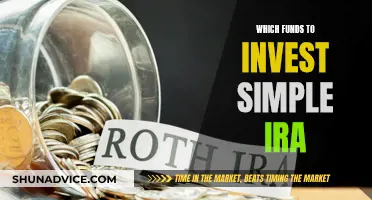
Pension fund managers have a responsibility to ensure that retirees receive the benefits they were promised. For many years, pension funds primarily invested in stocks and bonds, but changing market conditions have led to a shift towards other asset classes such as private equity, real estate, infrastructure, and inflation-hedging securities like gold. Pension funds are also increasingly investing in asset-backed securities and moving towards passive investment methods, such as index funds and exchange-traded funds. The aim is to balance risk and return to ensure the long-term solvency of pension programs.
| Characteristics | Values |
|---|---|
| Investment types | Company shares, property, bonds, student loans, credit card debt, private equity, hedge funds, commodities, derivatives, high-yield bonds, real estate, stocks, bonds, gilts, cash, equities |
| Investment strategy | Liability-matching, diversification, passive investment methods, focusing on index funds and exchange-traded funds (ETFs) |
| Risk | Higher-risk investments may lead to higher returns but are more volatile |
| Charges | Annual management charge, shown as a % taken from the pension pot |
What You'll Learn
- Pension fund managers invest in stocks, bonds, real estate, and other assets
- They must be prudently managed due to their lower risk tolerance
- Pension funds are increasingly investing in private equity, real estate, infrastructure, and securities like gold
- Pension fund managers are moving towards passive investment methods, focusing on index funds and exchange-traded funds (ETFs)
- They are also diversifying into alternative assets like commodities, high-yield bonds, and hedge funds

Pension fund managers invest in stocks, bonds, real estate, and other assets
Pension fund managers are responsible for investing a pool of funds specific to a certain group, such as teachers in a particular school district, city, or state. They are one of the largest types of institutional investors, with an estimated $40 trillion in assets under management globally.
Pension fund managers traditionally invest in stocks and bonds, but they have increasingly diversified their portfolios in the 2020s. This is due to changing market conditions and the need to maintain a high rate of return. Pension fund managers now invest in a variety of asset classes, including:
- Private equity
- Real estate
- Infrastructure
- Securities like gold that can hedge inflation
- High-yield bonds
- Commercial real estate loans
- Asset-backed securities (ABS) such as student loans and credit card debt
- Riskier small-cap growth stocks and international equities
- Venture capital
- Hedge funds
Pension funds are important players in the financial markets, providing capital to businesses and helping to finance economic growth. They are also a significant source of capital for the private equity industry.
Pension fund managers use a variety of investment strategies, depending on the objectives of the fund. These strategies are designed to achieve the best risk-adjusted returns while keeping overall risk within acceptable parameters.
Corporations' Hesitance Towards Mutual Funds: Exploring the Why
You may want to see also

They must be prudently managed due to their lower risk tolerance
Pension fund managers have a fiduciary duty to act in the best interests of their clients, the future retirees. Pension fund assets must be prudently managed, with a focus on preserving capital and ensuring retirees receive their promised retirement benefits. This is due to their lower risk tolerance compared to other types of funds.
Pension funds have traditionally been invested primarily in stable stocks and bonds, with a focus on blue-chip stocks and investment-grade bonds. However, changing market conditions and the need to maintain high returns have led to a diversification of investment strategies. Pension funds are increasingly investing in a variety of asset classes, including private equity, real estate, infrastructure, and inflation hedges like gold.
While some pension funds are still managed actively, with fund managers regularly changing the composition of the fund, there is a growing trend towards passive investment methods. These passive methods involve replicating market indices through index funds and exchange-traded funds (ETFs). This shift reduces costs and provides a more stable investment strategy, as it is not dependent on the performance of individual stocks or bonds.
Additionally, pension funds are also investing in alternative assets, such as commodities, high-yield bonds, hedge funds, and real estate. These investments are often made through private equity funds, which pool investors' money to invest in non-public companies for long-term capital gains. Real estate investment trusts (REITs) are also becoming a popular choice for pension funds due to their passive investment approach and stable returns.
Pension fund managers must carefully consider the risk and return profile of each investment option, ensuring that the investments made are prudent and aligned with the long-term goals of providing stable retirement benefits to their clients.
Best Mutual Funds to Invest in This Year
You may want to see also

Pension funds are increasingly investing in private equity, real estate, infrastructure, and securities like gold
Pension fund managers have traditionally invested in "core assets" such as money market instruments, government bonds, and large-cap equity. However, in recent years, pension funds have started to invest in a wider variety of asset classes, including private equity, real estate, infrastructure, and securities like gold. This shift is due to changing market conditions and the need to maintain sufficiently high rates of return.
Private equity investments, for example, are a long-term alternative investment category that pension funds are increasingly allocating their substantial capital to. Private equity fund managers charge high fees and promise above-market returns.
Pension funds are also investing in real estate, either through passive investments in real estate investment trusts (REITs) or private equity pools, or by directly participating in the acquisition, development, or management of properties. These long-term investments are typically made in commercial real estate such as office buildings, industrial parks, apartments, or retail complexes.
Infrastructure investments have become an attractive asset class for pension funds, particularly in the wake of the 2008-2012 global recession. Infrastructure assets offer advantages such as long duration, facilitating cash flow matching with long-term liabilities, protection against inflation, and statistical diversification. Pension funds, including superannuation schemes, account for approximately 40% of all investors in the infrastructure asset class.
Securities like gold are another investment option for pension funds as they can hedge against inflation. Pension funds are increasingly investing in a variety of asset classes to ensure they receive sufficiently high rates of return while prudently managing their assets to guarantee retirees their promised retirement benefits.
Planning Mutual Fund Investments: A Guide to Success
You may want to see also

Pension fund managers are moving towards passive investment methods, focusing on index funds and exchange-traded funds (ETFs)
Pension fund managers are increasingly adopting passive investment strategies, with a focus on index funds and exchange-traded funds (ETFs). This shift towards passive investing reflects a broader trend in the investment landscape, as investors seek lower fees, simplified portfolio construction, and reduced trading costs.
Index funds, a popular form of passive investing, aim to replicate the performance of a specific market index, such as the S&P 500. By holding the same stocks or bonds, or a representative sample, index funds offer investors a simple and cost-effective way to gain diversified exposure to the market. The passive nature of index funds eliminates the need for active stock picking and market timing, resulting in lower fees and expenses compared to actively managed funds. This makes index funds attractive to pension fund managers, as it helps minimize costs while providing broad market exposure and diversification.
Exchange-traded funds (ETFs) are another vehicle for passive investing. ETFs are traded on exchanges like individual stocks, offering investors the flexibility of intraday trading, limit and stop-loss orders, and short selling. Similar to index funds, ETFs track a specific market index and provide diversified exposure at a lower cost. The ability to trade ETFs throughout the day and the potential for price accessibility by buying individual shares makes them an appealing option for pension fund managers.
The benefits of passive investing, including reduced costs and simplified portfolio management, have led to a significant shift away from active investing. According to research, passively managed funds have consistently outperformed their actively managed counterparts. This trend is evident in the growing popularity of passive funds, with an increasing proportion of pension fund assets being allocated to these investment strategies.
By focusing on passive investment methods, pension fund managers aim to maximize returns while minimizing costs. Index funds and ETFs provide a straightforward approach to investing, reducing the complexity and expenses associated with active management. This strategy aligns with the long-term nature of pension funds, as it seeks to build wealth gradually over time by replicating market performance and reducing trading fees.
Hedge Funds: Where Are They Investing Their Money?
You may want to see also

They are also diversifying into alternative assets like commodities, high-yield bonds, and hedge funds
Pension fund managers have traditionally invested in stocks and bonds, often using a liability-matching strategy. However, changing market conditions and the need to maintain high returns have led to a diversification of investment portfolios. Pension funds are increasingly investing in alternative asset classes such as commodities, high-yield bonds, and hedge funds.
Commodities, such as gold, are an important addition to pension fund portfolios as they can hedge against inflation. The inclusion of these assets is part of a broader strategy to protect against the eroding effects of inflation on the purchasing power of retirees' benefits. This is especially important for pension funds, which often have a long time horizon and are designed to provide retirement income for many years. Commodities also offer diversification benefits, as their performance is often not closely correlated with traditional asset classes such as stocks and bonds.
High-yield bonds are another alternative asset class that pension fund managers are utilising. These bonds offer the potential for higher returns compared to traditional investment-grade bonds. The higher returns come with increased risk, as issuers of high-yield bonds are often companies with lower credit ratings or higher default probabilities. However, pension fund managers can balance this risk by investing in a diversified portfolio of high-yield bonds, carefully assessing the creditworthiness of the issuers, and considering the overall risk profile of the pension fund.
Hedge funds are also becoming an attractive option for pension fund managers. Hedge funds employ a wide range of investment strategies, including long/short equity, event-driven, market-neutral, and others. These strategies can provide pension funds with exposure to a diverse set of assets and help manage risk. Hedge funds often have more flexibility in their investment strategies compared to traditional investment funds, allowing them to adapt to changing market conditions and seek out opportunities for higher returns.
By diversifying into these alternative assets, pension fund managers are aiming to balance risk and return, protect against inflation, and ultimately ensure that retirees receive their promised benefits. The inclusion of these alternative investments in pension fund portfolios is a shift from the traditional investment strategies and reflects the evolving nature of the investment landscape.
Best Direct Mutual Fund Investment Apps: Your Guide
You may want to see also
Frequently asked questions
Pension fund managers use a variety of investment methods, depending on the type of pension fund. These methods include investing in stocks, bonds, real estate, and other assets. Pension funds are typically diversified across different types of investments to minimise risk and take advantage of opportunities in the market.
The traditional investing strategy for pension funds is to split their assets among bonds, stocks, and real estate. Pension funds have historically invested primarily in stocks and bonds, using a liability-matching strategy.
Two of the most common types of pension funds are managed pension funds and tracker pension funds. Managed pension funds are actively managed by a fund manager or a group of fund managers to achieve the best returns. Tracker pension funds, on the other hand, are passively managed and aim to automatically follow a wider index such as the FTSE 500.







